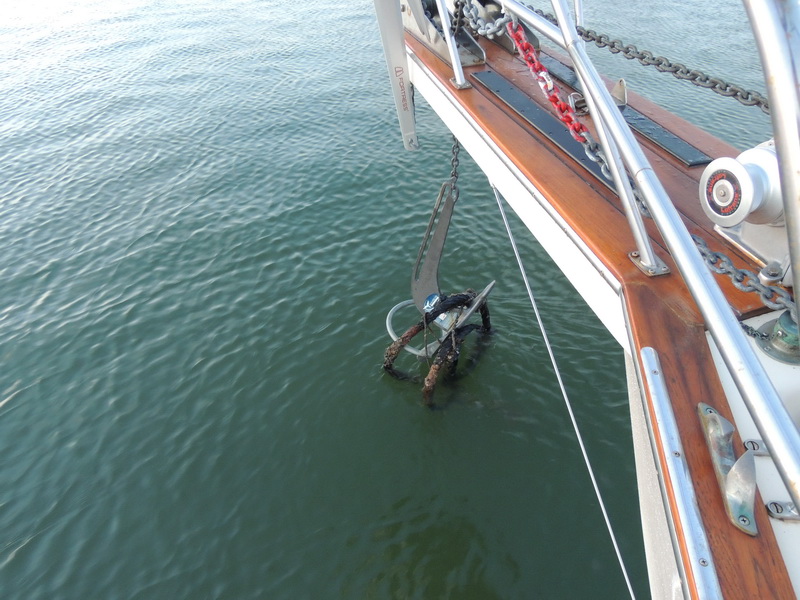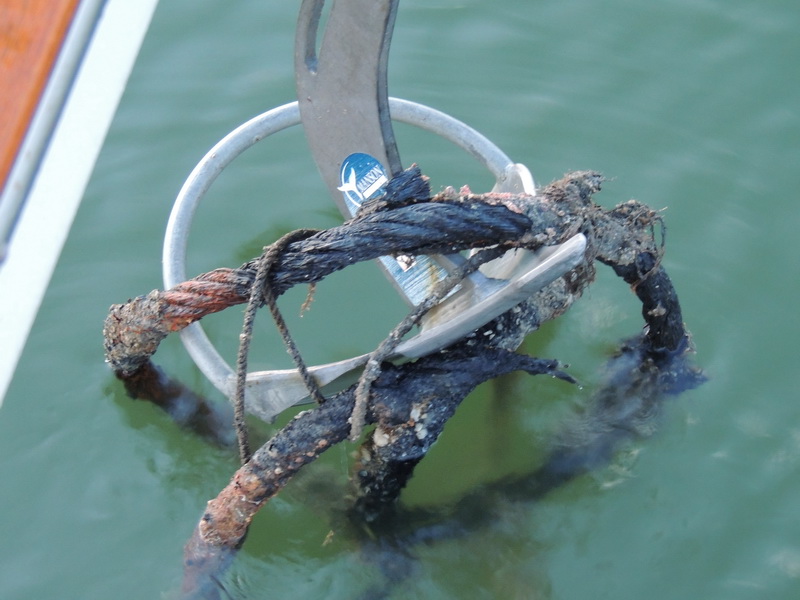Benthic2
Guru
Harder than tightening a 200 square foot mainsail in a stiff breeze ??
Harder than tightening a 200 square foot mainsail in a stiff breeze ??
When the motor crapped out on our Seawolf windlass, I used my Porter Cable 3/8 ac drill running off the inverter to raise 200' 5/16chain and a 65#anchor. Took me about 5 minutes to remove the motor and attach the chuck to the shaft of the pinion gear. Worked beautifully! I'm pretty sure it wouldn't have been able to do it if I had somehow been able to attach it directly to the shaft that the gypsy rode on.
Tator
WHY do you find a need for an 80-100 pound anchor on 58ft boat?
Anchor manufacturers' minimum recommendations. Actual solution might be heavier.
More on this, since I have numbers handy. First our boat is nominally 58', started life as a "550" until it got a big-a$$ bustle (swim platform) in our model year, and it actually measures approx 61. Weighs ~52K lbs.
So we've got length, weight, and high windage to deal with. (Can't take a reef in our flybridge...)
SARCA suggests a 79-lb Excel #7 for boat weights between 46-53K lbs and 51-57' long. Or their 88-lb Excel for boat lengths of 57-63' and between 52-61K lbs.
SPADE suggests their 99-lb S180 for boat weighing between 51-57K lbs. Actually, their chart is wonky; they suggest a 55-lb S120 for boats between 52-59'... but the boat weight they associate with that length is less than ~35K lbs and I guess likely a sailboat configuration.
Rocna suggests their 121-lb Vulcan 55 for boat length 59' and boat weight up to 55K lbs.
So from those choices, the proposed minimum galvanized steel non-rollbar anchor weight could be something like 88 lbs. Or 99 lbs. Or 121 lbs. And that's without yet having gone up a size or 2, as many are wont to do (and as I'd also consider, depending on what could fit).
And then there's the remaining length of chain after we've come up over the anchor. Usually that'd be less than 20' of chain.
The Lofrans windlass is "designed for boats from 12 up to 18 mts in length" but the manual doesn't specify max anchor weight.
-Chris
Everything on a boat can fail. Fortunately an average person can raise an anchorI would say you are making a big fuss over nothing.
Provided it's a quality, properly sized windlass, properly installed and maintained, the chances of it failing suddenly are pretty slim.
If you can't turn the windlass with a winch handle, you aren't going to be able to use a drill either. The drill will put just as much torque into your wrist as it is into the windlass (Newton's 3rd, eh?) and if you couldn't hold the winch handle you won't be able to hold the drill.
So... if the windlass craps out for whatever reason... what are likely ways to haul in something heavier than I can easily haul?
If I'm reading the Rocna chart correctly, they recommend the 40 kg / 88 lb Vulcan for 59' / up to 55k lbs. At 59', they say the 55 kg / 121 lb unit is good for 110k lbs. So it seems like the 90 - 100 lb range is what most manufacturers suggest. Something in the 110 - 120 lbs would probably be a reasonable oversize.
As far as your windlass, Lofrans says it's rated to pull 1850 lbs. Being conservative and figuring 25% as working load (I don't see a working load spec published), that leaves 462 lbs. Even with the 121 lb anchor and 3/8" chain (at 1.5 lb / foot), you could pull the anchor up in 200 feet of water (so lifting 200 feet of chain + anchor being lifted) and still be below the working load. I'd say the windlass is strong enough that you shouldn't need to worry about it as far as anchor sizing.
First put on gloves. sit on deck where you can grasp the chain without it fouling
on the inoperative windlass or some other structure. Engage the chain stopper.
Start taking up the chain using your upper body in a rowing motion. The stopper
will allow you to ratchet the chain between the rising and falling of the boat's bow.
Eventually you will be dead-lifting the weight of the remaining chain and anchor.
At that point you may need a second person but the boat will at least be free of
the bottom and able to maneuver if needed. I have done this with a 40Kg CQR.
How about a counterweight? I have a spare anchor, some 10lb downrigger balls. So you pull the rode (chain or rope) from the locker below the winch and feed it over the bow roller or? some 10 feet to start. Add the weight to say 50% of gear down. Now you are hauling up 1/2 the weight as your counter is going down. Once you get the main anchor on board if needed disconnect the main anchor, add other weight and do in reverse until you are able to just pull up the rest.
Hmmm... thanks. I think you must have used the "Fitment Guide" here?
https://rocna.com/fitment-guide/
Some of that makes more sense to me. Yesterday I had used their "Anchor Selector (Short Tonnes, Standard/Open, 59, 55.1) and that's what got the Vulcan 55/121 answer.
https://rocna.com/anchor-selector-2/?wpce_search=4671&post_type=product
Just now, I filled in the dialog questions (Imperial, Standard/Open, 59, 55,120 lb) and today's answer is Vulcan 40kg/88lbs.
Better!
This all helps a lot! because I already made a cardboard mockup of the Vulcan 40.
I hadn't found that Lofrans spec, so that helps. too. The Instruction Manual I have for the Project 1500 USA version doesn't include it. I found a combined Installation and User's Manual for the European version (and also the more recent X3 and X3ALU models) that says 1320 or 1760 max lift and 363 or 440 max working lift (1500W and 1700W models, respectively). That said, I haven't been too worried about the windlass lift capability.
Unless it breaks while we're on the hook.
-Chris
I also have the Lofrans Tigres windless with a 66 pound anchor and 320 feet of chain. My plan if the windless fails ….
1. Manual lift with the provided handle (and a pipe?)
2. Somehow rig my 5/1 block and tackle to slowly lift it
3. Somehow rig my boat deck crane to provide some lifting
These last two would require a pulley rigged somewhere to transfer load, or rig the block and tackle to the Samson Post?
Mostly, good maintenance is my plan! ;-D
I have a Lofrans tigress. I use it to lift 100# sail mark anchors every fall. Both 12v and manual. It is slow by hand but works great. I have all chain rode with a mantus 55. Don’t underestimate that windlass.
I can imagine seeing your props out of water. wowYears ago I was the anchor boat in a raft of 3 at the Ruxton Passage end of DeCourcey Island. The rafted boats left and I used my Lofrans Tigress to recovery my anchor. It was a tough lift, as the anchor was fouled. Eventually I gat a trailer to the surface, the kind that UHaul might rent out for hauling a car. Without wheels, so maybe only 1200 to 1500#. The Tigress did this lift and then lasted another 20 years in regular use before I had it rewound.
Don't underestimate your own.
Years ago I was the anchor boat in a raft of 3 at the Ruxton Passage end of DeCourcey Island. The rafted boats left and I used my Lofrans Tigress to recovery my anchor. It was a tough lift, as the anchor was fouled. Eventually I gat a trailer to the surface, the kind that UHaul might rent out for hauling a car. Without wheels, so maybe only 1200 to 1500#. The Tigress did this lift and then lasted another 20 years in regular use before I had it rewound.
Don't underestimate your own.

Step back a second. If the windlass dies, ignoring the fact that your anchor is on the bottom, what's your NEXT step? Are you going to point to bow to the nearest logical spot where you can get it repaired? Are you going to ignore the dead windlass and anchor out several more times, knowing full well that you'll have to manually hoist that anchor?
Why not tie some fenders to the chain and let the anchor take a nap while you run to town and get the windlass fixed? Or hire someone to fetch it for you (who has a functional windlass, or any other contraption that'll bring it up without manual effort)? Once your windlass is fixed, you can hoist the anchor right back where it was, easy peasy.
Step back a second. If the windlass dies, ignoring the fact that your anchor is on the bottom, what's your NEXT step? Are you going to point to bow to the nearest logical spot where you can get it repaired? Are you going to ignore the dead windlass and anchor out several more times, knowing full well that you'll have to manually hoist that anchor?
Why not tie some fenders to the chain and let the anchor take a nap while you run to town and get the windlass fixed? Or hire someone to fetch it for you (who has a functional windlass, or any other contraption that'll bring it up without manual effort)? Once your windlass is fixed, you can hoist the anchor right back where it was, easy peasy.
I believe it. We had a 12v Tigres on our IP and lifted a big coil of old cable off Cayo Costa several years back. I have no idea how much was below the surface, but it was a lot - The windlass had no trouble with it (unlike me when I had to get the stuff off the anchor...)
Unhooking the anchor from whatever it is fouled on can be a huge PITA. In my case, using my dinghy, I was able to tie a stout rope to the trailer, then let the anchor down enough to clear, recover the anchor, then back out of that anchorage to deeper water where dumping the trailer would never see it troubling anchored boats again.

Yup, I used the chart. Interesting that the selector gives a different answer. Realistically, if they fit, I'd be looking at one of the 100+ lb choices. Spade gives a choice of 99 or 121 lbs, Excel you can go to 110 or 120. Vulcan makes 121 the step up.
In my mind, that would likely depend on where I am, what broke and how quickly I can get parts. Realistically, if I needed to anchor again, I'd likely use the backup Fortress, as it's much more manageable to haul in by hand.
